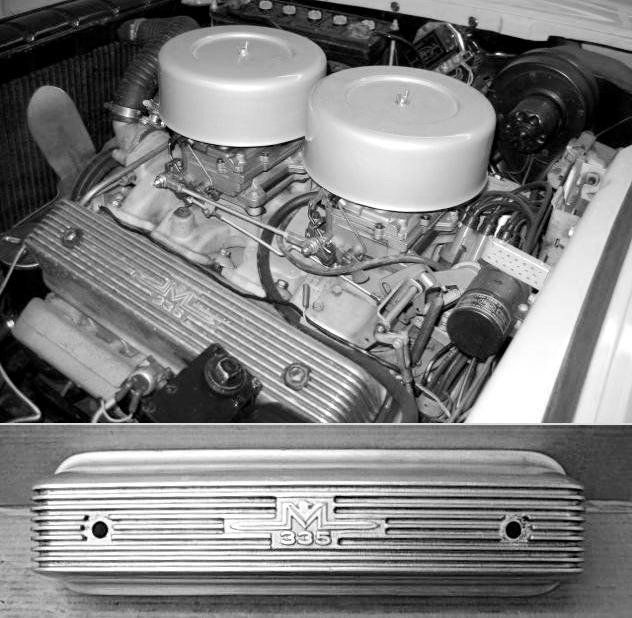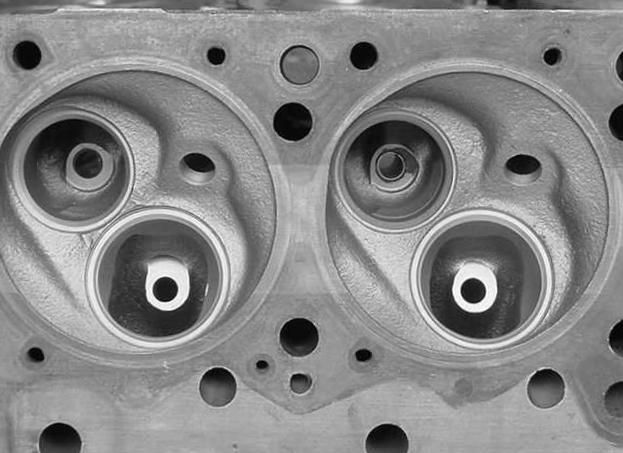
Pictured above: 1957 Lincoln 368 cubic inch M335 V8
_____________________________________
The Era of the mid-size muscle car motors
Ford's 351 V8s were not the first mid-size V8s Ford manufactured, there was in fact a brief period in time when almost every US automaker offered consumers a high output mid-size V8 as their top performance option. Ford's 351 V8s were a return to a proven formula.
In 1955 Chevrolet began supporting a race car driver in NASCAR for bragging rights, to equate a victory in competition with a better performing production automobile; this was a method to promote their new small block V8. The promotion appeared to be working as Chevrolet sales were up, the other automakers took notice and began sponsoring racing efforts too. Since the rules only allowed drivers to race with parts that were sold on the showroom floor the automakers installed their hottest motors in limited edition high performance cars to sell to the public. As the competition amongst the manufacturers began to escalate the displacement and horsepower output of each manufacturer's top performing motor began to grow. In the mid to late fifties there was a brief period of time (1956 to 1960) when each US automaker had stepped up to a mid-size V8 (325 to 375 cubic inches) as their top performance option.There were some outstanding motors made in that era with dual quads, triple dueces, air gap intake manifolds, hemi heads, etc.
1956 AMC 327 c.i. 255 bhp V8
1957 Buick 364 c.i. 300 bhp Nailhead V8
1958 Cadillac 356 c.i. 335 bhp dual quad V8
1960 Chevrolet 348 c.i.350 bhp Turbo Thrust triple deuce V8
1956 Chrysler 354 c.i. 355 bhp Fire Power dual quad V8
1957 De Soto 345 c.i. 345 bhp Fire Dome dual quad V8
1957 Dodge 325 c.i. 310 bhp Red Ram dual quad V8
1960 Ford 352 c.i. 360 bhp Interceptor V8
1957 Lincoln 368 c.i. 335 bhp M335 dual quad V8
1957 Oldsmobile 371 c.i. 312 bhp Golden Rocket triple deuce V8
1956 Packard 374 c.i. 310 bhp dual quad V8
1957 Plymouth 318 c.i. 290 bhp Hy-Fire dual quad V8
1957 Pontiac 347 c.i. 290 bhp Super Chief triple deuce V8
Not only did the mid size V8 originate in that era, the canted valve head originated in that era too. The early Mopar hemi motors had the typical broad valve covers with the spark plugs inserted through the middle of the valve covers, similar in appearance to the 1960s era 426 hemi motor. These motors had dual rocker shafts per head under those broad valve covers. The hemi was expensive to manufacture and was reserved for the high-end automobiles in the Chrysler line-up. There was another Mopar V8 motor in that era however with a single rocker shaft per head, they're called polyspherical motors, or poly head motors.

Pictured above: the combustion chamber of Chysler's mid-1950s polysherical cylinder head
The polyspherical motors were the inexpensive motors, for the lower priced cars in the Chrysler line-up. The poly head motor employed cylinder heads that came close to the port geometry, combustion chamber design and power capabilities of the hemi head motors but were less expensive to manufacture. They are identified by their scalloped valve covers, somewhat similar to the 348/409 Chevy valve covers. The scalloped head and valve covers allowed easy access to the spark plugs which did not insert through the valve covers. These are the first canted valve head motors, the inspiration for the Mk IV (big block) Chevy, the 385 series Ford and the 335 (Cleveland) series Ford.
It was a memorable era for the American automobile, enthusiasts of the various automakers admire the motors from this period even today. Motors of this size had proven to be a powerful step up from the smaller displacement V8s that precedeed them and very popular with automotive enthusiasts. The strong performance of the motors from this era had not been forgotten by Ford’s managers either. Both Lincoln's 335 horsepower M335 dual quad V8 (368 cubic inches) and Ford's 360 horsepower Super Interceptor V8 (352 cubic inches) were spirited performance motors.
________________________________________
The compact and mid-size muscle cars of the mid-1960s were unsafe; their 389 to 440 cubic inch motors, some of which were merely detuned racing motors, overwhelmed the chassis, the brakes and the street tires of the day, there was no such thing as electronic traction control in the 1960s. The automakers were building unsafe cars, Ford managers did not think this was appropriate for a manufacturer of public transportation.
Ford management was not considering halting production of performance cars, they projected the demand for performance cars would continue. But the need for a smaller displacement performance motor was recognized ... a motor offering safer balanced performance while still being exciting to drive. A motor that didn't overwhelm the chassis or tires as much as the performance motors being sold in 1965. The question was, how far to downsize?
Studies were conducted with engines of various displacement installed in compact (Mustang, Falcon) and mid-size (Fairlane) chassis and it was found the acceleration performance of a mid-size V8 powered production car on street tires and unmodified chassis was superior to the acceleration with a smaller V8 but equal to the acceleration with a 425+ horsepower larger V8 under the same conditions. All the extra horsepower of the big V8 simply spun the tires more and made traction more difficult to control. The managers had their answer. It was time to move forward by stepping backwards ... stepping backwards to mid-size motors like the 368 cubic inch Lincoln M335 V8 (1957) and the 352 cubic inch Super Interceptor V8 (1960).
I remain a strong believer in the concept of balanced performance for performance street & sports cars.
-G

